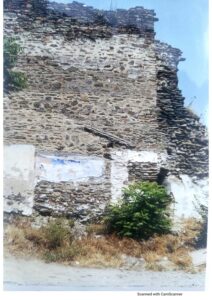Traces of a refugee house on the walls
City
City Narratives
Category
Full Description
The photograph shows the traces of a house on Eptapyrgiou Street which was built abutting the Byzantine Walls of Thessaloniki after 1922. Greek refugees were given the houses vacated by the Turkish families leaving Ano Poli, a process which intensified after the signing of the population exchange treaty between Greece and Turkey in January 1923. A large number of the Christian refugees who arrived in Thessaloniki also settled in house yards and empty plots of land or other empty spaces, erecting their own makeshift dwellings.
Nowadays, the houses that abut the Byzantine Walls have been condemned (indicatively, see GG 313 D/31.5.1979, GG 27D /13.2.1986 and GG A 153/28.06.2002). Many properties along the walls have been appropriated and replaced by a zone of greenery in order to showcase the Byzantine Walls. Local residents called these houses ‘καστρόπληκτα’ (pronounced ‘kastroplikta’ which means ‘castle-stricken’), since their existence was threatened by the city walls, also known as ‘castles’ (see also ΧΤΤ005). For years, ‘kastroplikta’ were a bone of contention between local residents and authorities, reflecting broader disputes over space and its qualitative characteristics, as well as the importance of maintaining the residential character of the area.
Bibliography
Agis Anastasiadis and Panos Stathakopoulos, ‘The characteristics of Pano Poli through history, urban planning and local architectural typology’, Thessaloniki after 1912 (Symposium), p. 452-473, Thessaloniki History Centre Publications, Issue No. 2, Thessaloniki 1986.
Eftychia Voutyra, ‘The “successful” rehabilitation of the Asia Minor refugees’, in Konstantinos Tsitselikis (ed.), The Greek-Turkish population exchange, aspects of a national conflict, Kritiki, Athens 2006.
Law 3028/2002 – GG A 153/28-06-2002
Presidential Decree – GG 27D/13.2.1986
Presidential Decree – GG 313 D/31.5.1979

